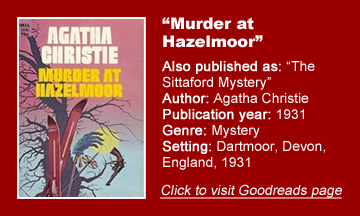Agatha Christie juggles a lot of ideas and jumps between a lot of characters in “Murder at Hazelmoor” (1931, also published as “The Sittaford Mystery”). I was engrossed in the mystery and always looked forward to knocking off a couple chapters, and the author plays fair with the solution, but “Hazelmoor” didn’t stick with me as much as some other Christie yarns. I think this is because so much is crammed into one novel.
Stacked with suspects
It has so many characters that even in the final pages I was thinking “Who’s that again?” There’s a “Captain” and a “Major,” not to mention an “Inspector” and a “Constable.”
There’s a “Rycroft” and a “Wyatt,” so I couldn’t even use the “Y” as a signifier to remember someone. Yet the police’s main suspect – the one who we as readers know could not have done it – remains entirely off-page.
Christie creates the nicely isolated community of Sittaford, a cluster of cottages six miles uphill from Exhampton, but that’s a long six miles in a snowstorm.
Nonetheless, Major John Burnaby trudges downhill through the storm and thick snow to visit his best friend, Captain Joseph Trevelyan, who he fears may have been murdered.
Hint of supernatural
The reason for Burnaby’s belief is a classic example of an author seemingly writing herself into a corner to see if she can get out: At Sittaford House (owned by Trevelyan, who is renting it out to the mother-and-daughter Willetts), the community gathers for a game of “table turning.”
Today’s equivalent is Ouija. A “spirit” announces that Trevalyan is dead, and after his trek to town, Burnaby learns this to be true.
Christie gave a hint of the supernatural in “The Mystery of the Blue Train,” but that could be written off as one character’s feeling. Here, it’s harder to explain away. I didn’t expect the author would truly incorporate the supernatural, but it’s still a good hook.
In “Hazelmoor” (named after the house Trevelyan is renting), characters are in focus for a while then disappear for long stretches, ceding the floor to someone else. In a way, the novel is a series of fits and starts that doesn’t gain traction like it should. And yet, these fits and starts are often good stuff.
Amateur sleuth
Emily Trefusis emerges as the most memorable figure. The fiancée of the off-page accused man, Emily is an amateur sleuth who uses her feminine charms to get other people to serve as her assistants.
Granted, Inspector Narracott is one of those rock-solid official investigators, similar to Superintendent Battle, whom Christie respects so much. At one point, Narracott tells Emily that real police detectives are not like those in novels: They are not looking to pin a murder on a convenient patsy; they are interested in finding the guilty party.
And Charles Enderby, Emily’s partner in amateur sleuthing, is a journalist. So it’s a good professional partnership for him. Emily is using him more in the sense of allowing him to believe he has a romantic chance with her.

At the end of the day, “Hazelmoor” doesn’t have the most likeable dramatis personae you’ll find in a Christie book. Emily is interested in how people can be of use to her.
Almost everyone else is hiding something, perhaps of a criminal nature. Sittaford includes a mean ole cat lady who never leaves her house, plus a mysterious man who never ventures from his abode. By the end we learn we were right to mistrust most of them – even if they aren’t the murderer.
Some characters are broad and humorously colorful, notably Mrs. Curtis (who provides rooms for Emily and Charles, posing as a couple, in Sittaford).
Her husband’s conversational contributions consist of grunts, but Mrs. Curtis is a fount of information on Sittaford residents. The young detectives can say a name and she’s like Siri reading a Wikipedia entry; the only trick is to steer her to relevant information.
Dead of winter
Initially, “Hazelmoor” has a decently foreboding sense of place, as it’s set in the dead of winter in slushy England. Sittaford overlooks a moor — an open field – that’s more beautiful in the summer. But the Willetts, from South Africa, say they love this weather because it’s new to them. About a dozen times, someone questions them on that unusual stance.
Although Christmas is approaching, there isn’t a sense of holiday warmth except for the opening gathering at Sittaford House – at least until the ghostly announcement of Trevelyan’s death. Ultimately, “Murder at Hazelmoor” doesn’t have enough decorative trappings to be a holiday classic.
But — driven by a mystery that doesn’t lose its grip even when Christie colors outside the lines – it’s not lump of coal by any means.
Every week, Sleuthing Sunday reviews an Agatha Christie book or adaptation. Click here to visit our Agatha Christie Zone.


